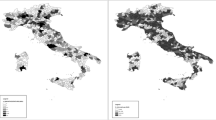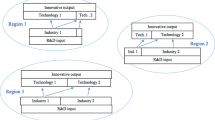Abstract
Growth driven by innovation is of great importance to help China become a long-term economic force and gain international competitive advantage. Based on evolutionary economic geography theory, this study estimated the related variety and unrelated variety by using four-digit code classified industrial data; it analysed their spatial–temporal evolution and influence on China’s regional innovation levels using prefecture-level city data from 1998 to 2013. Results showed that average levels of related variety increased whereas unrelated variety declined. Regions with high related variety spread from the east coastal region to the central region of China, and regions with high unrelated variety moved from the northeast and north regions to the central region. Related variety promoted innovation by knowledge spillover and produced regional spillover and agglomeration effects among regions with similar levels of economic development. Conversely, unrelated variety hindered the growth of innovation and had no regional spillover among different regions. Technological innovation was the transmission mechanism of growth from related variety to economic development. Thus, it is necessary to strengthen the agglomeration effects of industries with related variety and improve each region’s innovation capacity.


Similar content being viewed by others
Change history
17 September 2021
A Correction to this paper has been published: https://doi.org/10.1007/s12061-021-09427-x
References
Boschma, R., & Capone, G. (2015). Institutions and diversification: Related versus unrelated diversification in a varieties of capitalism framework [J]. Research Policy, 44(10), 1902–1914.
Boschma, R., & Frenken, K. (2011). The emerging empirics of evolutionary economic geography [J]. Journal of Economic Geography, 11(2), 295–307.
Boschma, R., & Iammarino, S. (2010). Related variety, trade linkages, and regional growth in Italy. Economic Geography, 85(3), 289–311.
Cheng, Y., Wang, Z., & Ma, J. (2014). Analyzing the space-time dynamics of innovation in China[J]. Acta Geographica Sinica, 69(12), 1779–1789.
Department of Comprehensive Statistics and Department of Rural Survey of National Bureau of Statistics. (1999-2014). China regional economic statistical yearbook[M]. China Statistics Press.
Department of Urban Social and Economic Investigation of National Bureau of Statistics. (1999-2014). China urban statistical yearbook[M]. China Statistics Press.
Fan, P., & Lang, H. (2000). The measurement of relatedness: an application to corporate diversification[J]. Journal of Business, 73(4), 629–660.
Frenken, K., Oort, F., & Verburg, T. (2007). Related variety, unrelated variety and regional economic growth[J]. Regional Studies, 41(5), 685–697.
Glaeser, L., Kallal, D., Scheinkman, A., et al. (1992). Growth in cities[J]. Journal of Political Economy, 100(6), 1126–1152.
Griliches, Z. (1979). Issues in Assessing the Contribution of Research and Development to Productivity Growth[J]. Bell Journal of Economics, 10(1), 92–116.
He, C. (2018). Regional industrial development and evolution: Path dependence or path creation?[J]. Geographical Research, 37(07), 1253–1267.
Hidalgo, C., Klinger, B., Barabasi, A., et al. (2007). The product space conditions the development of nations[J]. Science, 317(5837), 482–487.
Howell, A., He, C., Yang, R., et al. (2016). Agglomeration, (un)-related variety and new firm survival in China: Do local subsidies matter? Papers in Regional Science, 97(3), 485–501.
Hu, X., & Hassink, R. (2017). New perspectives on restructuring of old industrial areas in China: A critical review and research agenda[J]. Chinese Geographical Science, 25(1), 110–122.
Jacobs, J. The Economy of cities[M]. Random House, 1969.
Jiao, J., Wang, J., & Cheng, K. (2017). Spatial-temporal evolution and spillover effects of regional innovation ability in China[J]. Economic Geography, 37(09), 11–18.
Jin, L., He, C., Zhou, Y., et al. (2017). Path creation in China’s industrial evolution[J]. Progress in Geography, 36(08), 974–985.
Liu, Z., Yin, Y., & Sun, J. (2011). A review of the research progress on industrial cluster formation from the perspective of evolutionary economic geography[J]. Progress in Geography, 30(6), 652–657.
Marshall, A. (1890). Principles of economics[M]. Macmillan.
Martin, R., & Sunley, P. (2015). On the notion of regional economic resilience: conceptualization and explanation[J]. Papers in Evolutionary Economic Geography, 15(1), 1–42.
Miguelez, E., & Moreno, R. (2018). Relatedness, external linkages and regional innovation in Europe[J]. Regional Studies, 52(05), 688–701.
National Bureau of Statistics of China. (1999-2014). China city statistical yearbook[M]. China Statistics Press.
Ren, J., & Yang, Q. (2008). Theory and demonstration between the industry diversion and city increase: A case study of 31 provincial cities in China[J]. Scientia Geographica Sinica, 28(5), 631–635.
Suire, R., & Vicente, J. (2009). Why do some places succeed when others decline? A social interaction model of cluster viability[J]. Journal of Economic Geography, 9(3), 381–404. https://doi.org/10.1093/jeg/lbn053
Song, H., & Zhang, M. (2017). Spatial spillovers of regional innovation: evidence from Chinese provinces[J]. Emerging Markets Finance and Trade, 53(09), 2104–2122.
Su, H., Zhao, J. (2012). Related Variety, Unrelated variety and regional industry development: evidence from Chinese 31 provincial-units industrial panel data[J], Industrial Economics Research, 57(02): 26–32.
Sun, X., & Chai, L. (2012). Related Diversification, unrelated diversification and regional economic development: evidences from panel data on China’s 282 prefecture-level City[J]. China Industrial Economics, 291(06), 5–17.
Wang, J. (2016). Agglomeration economy, correlation variety and urban economic growth: empirical analysis based on panel data of 279 cities at prefecture level of above[J]. Journal of Finance and Economics, 42(05), 135–144.
Wei, W., & Zheng, Y. (2013). The study of regional economic development based on related and unrelated variety[J]. Statistics & information, 28(10), 49–55.
Yang, N., Liu, Q., & Qi, Y. (2020). Does (un)-related variety promote regional innovation in China? Industry versus services sector[J]. Chinese Management Studies, 14(03), 769–788.
Funding
The Auspices of MOE (Ministry of Education in China) Project of Humanities and Social Sciences (Project No. 19YJC790043).
Author information
Authors and Affiliations
Corresponding author
Additional information
Publisher’s Note
Springer Nature remains neutral with regard to jurisdictional claims in published maps and institutional affiliations.
The original version of this article was revised: The original version of this article unfortunately contained missing funding statement.
Rights and permissions
About this article
Cite this article
Huang, Y., Fang, Y. & Gu, G. Innovation Effect and Regional Difference of Related Variety: An Empirical Study Based on Prefecture-level City Data of China. Appl. Spatial Analysis 15, 441–454 (2022). https://doi.org/10.1007/s12061-021-09404-4
Received:
Accepted:
Published:
Issue Date:
DOI: https://doi.org/10.1007/s12061-021-09404-4




